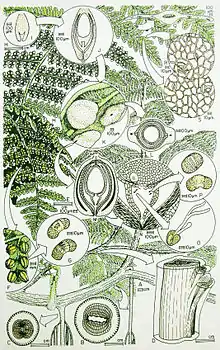Callistophytales
The Callistophytales was an order of mainly scrambling and lianescent plants found in the wetland "coal swamps" of Euramerica and Cathaysia. They were characterised by having bilaterally-symmetrical, non-cupulate ovules attached to the underside of pinnules that were morphologically similar to the "normal" vegetative pinnules; and small compound pollen-organs, also borne on the underside of unmodified pinnules, that produced saccate pollen.[2] They were reproductively more sophisticated than most other Palaeozoic pteridosperms, some of which they seem to have out-competed and replaced in the "coal swamp" vegetation during Late Pennsylvanian and Permian times.
| Callistophytales Temporal range: | |
|---|---|
 | |
| Reconstruction of the plant Callospermarion pusillum (permineralized ovules), Idanothekion callistophytoides (pollen organ), Dicksonites pluckenetii (leaves), Callistophyton poroxyloides (stem), and Vesicaspora shaubergeri (pollen) from the Pennsylvanian Calhoun Formation of Berryville, Illinois.[1] | |
| Scientific classification | |
| Kingdom: | Plantae |
| Clade: | Tracheophytes |
| Division: | †Pteridospermatophyta |
| Class: | †Lyginopteridopsida (?) |
| Order: | †Callistophytales G.W.Rothwell 1981, emend. 1982 |
| Families | |
The inclusion of the Callistophytales within the Lyginopteridopsida is controversial because of the apparent sophistication of the ovules and pollen.[3] There are nevertheless many other characters that suggest that the Callistophytales is derived from a more primitive lyginopterdalean-like ancestor, including the presence of a lagenostome at the apex of the nucellus, the general structure of the pollen organs, and the overall morphology of the vegetative structures.
Two families have been recognised: the Callistophytaceae, known mainly from the Carboniferous floras of Euramerica; and the Emplectopteridaceae, known mainly from the Permian floras of China and adjacent areas.
References
- Retallack, G.J.; Dilcher, D.L. (1988). "Reconstructions of selected seed ferns". Missouri Botanical Garden Annals. 75: 1010–1057.
- Anderson J. M.; Anderson H. M.; Cleal C. J. (2007). "Brief history of the gymnosperms: classification, biodiversity, phytogeography and ecology". Strelitzia. 20: 1–279.
- Hilton, J.; Bateman, R. M. (2006), "Pteridosperms are the backbone of seed-plant phylogeny", Journal of the Torrey Botanical Society, 33: 119–168, doi:10.3159/1095-5674(2006)133[119:PATBOS]2.0.CO;2